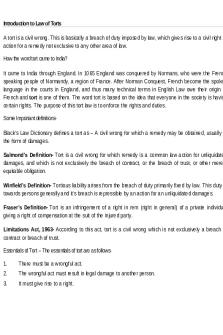Introduction to Civil Law PDF

| Title | Introduction to Civil Law |
|---|---|
| Author | Jimmy Vailer |
| Course | Engineering Law |
| Institution | University of Ottawa |
| Pages | 1 |
| File Size | 55.7 KB |
| File Type | |
| Total Downloads | 75 |
| Total Views | 191 |
Summary
Lecture notes on Civil Law...
Description
Introduction to Civil Law The civil law tradition. 1) Written: civil codes contain a comprehensive statement of rules. 2) Many are framed as broad, general principles to deal with any dispute that may arise. 3) Unlike common-law courts, courts in a civil-law system first look to a civil code, then refer to previous decisions to see if they're consistent. The term “civil law” is used to mean two quite different things: 1) used in contrast to “common law” to refer to the legal system that is based on civil code (such as the Justinian code or the Civil Code of Quebec). 2) refers to matters of private law as opposed to public law (particularly criminal law, which is concerned with harm to society at large). Bijuralism Co-existence of two legal traditions (civil law and common law) in Canada. This coexistence found its first formal expression in the Quebec Act, 1774. After the Battle of Quebec in 1759, the country fell under English common law, except for Quebec, which follows civil law. The division of powers found in the Constitution Act, 1867 confirmed this coexistence by expressly providing at subsection 92(13) that, outside the federal heads of power found under section 91, “Property and Civil Rights in the Province” fall within the exclusive jurisdiction of the provinces. This broad residuary power over property and civil rights in the province is exercised in Quebec in a civil law environment whereas, elsewhere in Canada, this power is set in a common law environment....
Similar Free PDFs

Introduction to Civil Law
- 1 Pages

Introduction to law
- 50 Pages

Introduction TO Contract LAW
- 5 Pages

Introduction to Law Essay
- 2 Pages

Introduction to Insolvency Law
- 22 Pages

Introduction to Employment Law
- 38 Pages

Introduction to criminal law
- 8 Pages

Introduction to Law
- 3 Pages

Introduction to Law of Torts
- 14 Pages

ILW 1036 introduction to law
- 28 Pages

1. Introduction TO Banking LAW
- 9 Pages

1-introduction to public law
- 11 Pages

Introduction to Halal Law ISH300
- 25 Pages
Popular Institutions
- Tinajero National High School - Annex
- Politeknik Caltex Riau
- Yokohama City University
- SGT University
- University of Al-Qadisiyah
- Divine Word College of Vigan
- Techniek College Rotterdam
- Universidade de Santiago
- Universiti Teknologi MARA Cawangan Johor Kampus Pasir Gudang
- Poltekkes Kemenkes Yogyakarta
- Baguio City National High School
- Colegio san marcos
- preparatoria uno
- Centro de Bachillerato Tecnológico Industrial y de Servicios No. 107
- Dalian Maritime University
- Quang Trung Secondary School
- Colegio Tecnológico en Informática
- Corporación Regional de Educación Superior
- Grupo CEDVA
- Dar Al Uloom University
- Centro de Estudios Preuniversitarios de la Universidad Nacional de Ingeniería
- 上智大学
- Aakash International School, Nuna Majara
- San Felipe Neri Catholic School
- Kang Chiao International School - New Taipei City
- Misamis Occidental National High School
- Institución Educativa Escuela Normal Juan Ladrilleros
- Kolehiyo ng Pantukan
- Batanes State College
- Instituto Continental
- Sekolah Menengah Kejuruan Kesehatan Kaltara (Tarakan)
- Colegio de La Inmaculada Concepcion - Cebu


